Ashka Jhaveri, Johanna Moore, Amin Soltani, Alexandra Braverman, and Nicholas Carl
The Iran Update provides insights into Iranian and Iranian-sponsored activities abroad that undermine regional stability and threaten US forces and interests. It also covers events and trends that affect the stability and decision-making of the Iranian regime. The Critical Threats Project (CTP) at the American Enterprise Institute and the Institute for the Study of War (ISW) provides these updates regularly based on regional events. For more on developments in Iran and the region, see our interactive map of Iran and the Middle East.
Note: CTP and ISW have refocused the update to cover the Israel-Hamas war. The new sections address developments in the Gaza Strip, the West Bank, Lebanon, and Syria, as well as noteworthy activity from Iran’s Axis of Resistance. We do not report in detail on war crimes because these activities are well-covered in Western media and do not directly affect the military operations we are assessing and forecasting. We utterly condemn violations of the laws of armed conflict and the Geneva Conventions and crimes against humanity even though we do not describe them in these reports.
Click here to see CTP and ISW’s interactive map of Israeli ground operations. This map is updated daily alongside the static maps present in this report.
Key Takeaways:Northern Gaza Strip: The Israel Defense Forces continued targeting Hamas commanders and fighters in the northern Gaza Strip.
Southern Gaza Strip: Israeli forces found medications belonging to Hamas-held hostages and weapons in Nasser Hospital in western Khan Younis.
West Bank: A Palestinian resident of east Jerusalem conducted a shooting attack in Kiryat Malachi on February 16, injuring four and killing two.
Southern Lebanon and Golan Heights: The Israel Defense Forces conducted a training exercise to increase the combat readiness of forces stationed on Israel’s northern border.
Iraq: Iraqi Prime Minister Mohammad Shia al Sudani met with the commander of NATO Allied Joint Force Command Naples to discuss NATO’s Mission Iraq.
Yemen: The Houthis likely conducted a missile attack targeting an unspecified Panama-flagged commercial vessel in the Red Sea.
Iran: Two unspecified Western officials and an IRGC-affiliated individual told the New York Times that Israel was responsible for the February 14 explosions on natural gas pipelines in central Iran.
Gaza Strip
Axis of Resistance campaign objectives:Erode the will of the Israeli political establishment and public to launch and sustain a major ground operation into the Gaza Strip
Degrade IDF material and morale around the Gaza Strip.
The Israel Defense Forces (IDF) continued targeting Hamas commanders and fighters in the northern Gaza Strip on February 16. The IDF 215th Artillery Brigade (assigned to the 162nd Division) killed an aide to the Sabra Battalion commander in Hamas’ Gaza City Brigade.[1] Israeli forces killed the previous Sabra Battalion commander in November 2023.[2] Hamas has likely replaced the Sabra commander since his death as part of its effort to reconstitute itself militarily in the northern Gaza Strip. Israeli aircraft struck a vehicle and killed three Hamas fighters in the northern Gaza Strip.[3]
Palestinian militias conducted two indirect fire attacks targeting Israeli forces in the northern Gaza Strip.[4] CTP-ISW cannot determine the point of origin at this time.
Israeli forces clashed with Palestinian fighters in the central Gaza Strip on February 16. The IDF Nahal Brigade (assigned to the 162nd Division) killed several Palestinian fighters, and the IDF Air Force targeted a Palestinian fighter squad near Israeli ground forces.[5]
Israeli forces found medications belonging to Hamas-held hostages and weapons in Nasser Hospital in western Khan Younis on February 16.[6] Israeli special operations forces began operating in Nasser Hospital on February 15 after receiving “credible intelligence” that Hamas-held hostages were in the hospital.[7] Israeli forces detained 20 fighters who participated in the October 7, 2023, attack as well as dozens of suspects for questioning.[8] The IDF Maglan Unit (assigned to the 98th Division) found mortars, grenades, and weapons belonging to Hamas in the hospital area.[9] The al Aqsa Martyrs’ Brigades, which is the self-proclaimed military wing of Fatah, claimed attacks targeting Israeli forces in the vicinity of Nasser Hospital for the third consecutive day.[10]
The IDF reported on February 16 that it has been causing “significant damage” to Hamas’ Khan Younis Brigade.[11] Israeli forces killed several Palestinian fighters, raided military targets, and disarmed an improvised explosive device (IED) in Khan Younis.[12] Several Palestinian militias attempted to defend against Israeli clearing operations, primarily in eastern Khan Younis, on February 16.[13] Israeli forces began conducting clearing operations in Khan Younis in early December 2023.[14]
Israel withdrew the IDF 646th Paratroopers Brigade from Khan Younis on February 15.[15] Only Israeli regular units remain in the Gaza Strip.[16]
Hamas policemen shot and killed a child, who was attempting to take food from a humanitarian aid truck in Rafah.[17] Riots erupted in the border area between Rafah and Egypt in response to the incident. The child’s family issued a statement holding Hamas responsible.[18] Israeli media reported that an unnamed Hamas official on the border denied the incident, saying that “there is no truth in what is being spread in the media and social networks.”[19]
Israeli Defense Minister Yoav Gallant said that Israel will not evacuate Palestinian civilians from Rafah to Egypt.[20] Gallant reported that Israel is “thoroughly planning future operations in Rafah” but did not offer more details.[21] Egypt has repeatedly raised concerns that an Israeli operation into the southern Gaza Strip will cause a flood of Palestinian refugees into Egypt and has even taken to reinforcing its border with the strip.[22]
US President Joe Biden reiterated to Israeli Prime Minister Benjamin Netanyahu that Israel must have a plan for ensuring the safety of civilians in Rafah before proceeding with a military operation.[23] An Israeli official reported that the conversation lasted 40 minutes. Israel has not publicly outlined a plan for how it would evacuate civilians from Rafah in the event of a military operation there.
Israeli President Isaac Herzog “secretly” met with Qatari Prime Minister Sheikh Mohammad Bin Abdulrahman al Thani to discuss the release of Hamas-held hostages in the Gaza Strip, according to two sources familiar with the meeting.[24] The two met on the sidelines of the Munich Security Conference. Israeli Prime Minister Netanyahu declined to send an Israeli delegation to Cairo for follow-up talks on February 14 due to Hamas’ demand that thousands of Palestinian prisoners be released as part of the deal.[25] An Israeli official told Axios that there is some progress and that Hamas may be willing to “soften its position.”[26]
Palestinian militias conducted three indirect fire attacks from the Gaza Strip into Israel on February 16. The al Aqsa Martyrs’ Brigades fired rockets targeting an Israeli military site and Ashkelon from the northern Gaza Strip.[27] Palestinian Islamic Jihad (PIJ) fighters also fired rockets targeting Ashkelon.[28] An Israeli military correspondent reported that three rockets landed in the sea.[29] The launches demonstrate that Palestinian militias in the northern Gaza Strip retain some ability to fire rockets into Israel, despite Israeli operations.
Recorded reports of attacks; CTP-ISW cannot independently verify impact.
West Bank
Axis of Resistance campaign objectives:Draw IDF assets and resources toward the West Bank and fix them there
A Palestinian resident of east Jerusalem conducted a shooting attack in Kiryat Malachi on February 16, injuring four and killing two.[30] Israeli media reported the gunman fired at a bus stop.[31] The Mujahideen Brigades boasted that terror attacks like this one evade Israeli security. Hamas responded to the attack by repeating its previous calls for Palestinian civilians to conduct terror attacks targeting Israelis.[32] Israeli Army Radio reported that the IDF found an identification card in the attacker’s vehicle and used it to identify the perpetrator.[33] Local footage showed Israeli forces engaged in clashes with unidentified Palestinian fighters in Shuafat shortly after the shooting attack.[34] Israeli Prime Minister Benjamin Netanyahu said that the attack north of Kiryat Malachi “reminds us that the whole country is a front and that the murderers, who come not only from Gaza, want to kill us all.”[35]
Israeli forces clashed with Palestinian fighters in three locations across the West Bank. The al Quds Brigades, which is the militant wing of PIJ, in Jenin fired at Israeli forces stationed at the Dotan checkpoint, south of the Israeli Mevo Dotan settlement.[36] Israeli forces arrested one wanted individual in Aqaba, east of Tubas, for shooting at Israeli forces.[37] Unidentified Palestinian fighters threw improvised explosive devices at Israeli forces around Aqaba.[38] Unidentified Palestinian fighters separately clashed with Israeli forces in Aboud.[39]
This map is not an exhaustive depiction of clashes and demonstrations in the West Bank.
Southern Lebanon and Golan Heights
Axis of Resistance campaign objectives:Draw IDF assets and resources toward northern Israel and fix them there
Set conditions for successive campaigns into northern Israel
The IDF Northern Command conducted a training exercise on February 16 to increase the combat readiness of forces stationed on Israel’s northern border.[40] The IDF 1st Golani Brigade of the 36th Armored Division and reserve forces from the 146th and 210th Divisions conducted a multi-day exercise to simulate combat on the border. Armored, infantry, engineering, and artillery units practiced camouflage techniques, open-field combat, and evacuations.
Lebanese Hezbollah conducted five attacks from southern Lebanon into northern Israel on February 16. Hezbollah conducted two rocket attacks targeting IDF facilities in Ruwaisat al Alam and al Malikiyah.[41] Hezbollah targeted Israeli forces at the Zibdin and Ruwaisat al Alam barracks in Shebaa Farms, using unspecified guided munitions.[42] Hezbollah targeted Israeli forces in a fifth attack in an unspecified area of northern Israel.[43]
Recorded reports of attacks; CTP-ISW cannot independently verify impact.
Iran and Axis of Resistance
Axis of Resistance campaign objectives:Demonstrate the capability and willingness of Iran and the Axis of Resistance to escalate against the United States and Israel on multiple fronts
Set conditions to fight a regional war on multiple fronts
Iraqi Prime Minister Mohammad Shia al Sudani met with the commander of the North Atlantic Treaty Organization’s (NATO) Allied Joint Force Command Naples Admiral Stuart Munsch to discuss NATO’s Mission Iraq (NMI) on February 16.[44] Sudani and Munsch discussed NMI’s intelligence sharing with and training Iraqi security officers as well as logistical issues for NMI following a withdrawal of international coalition forces from Iraq.[45] NMI works with Iraqi security forces in a ”non-combat advisory and capacity-building” capacity to ”prevent the return of ISIS/Daesh, fight terrorism, and stabilize their country.”[46] NMI operates in Iraq at the invitation of the Iraqi government.[47]
Badr Organization Secretary General Hadi al Ameri nominated Mohammed Jassim al Amiri on February 16 as a compromise candidate for governor of Diyala Province.[48] Mohammed Jassim al Amiri is the 28-year-old son of the president of Iraq’s Federal Supreme Court, Judge Jassim Mohammad Aboud.[49] Ameri claimed that his nomination was an attempt to break the political deadlock delaying the appointment of a governor. Provincial councils are responsible for voting a governor into office, under Iraqi law.[50] Ameri’s decision to nominate the candidate for Diyala Province is particularly noteworthy given the military and political influence the Badr Organization has historically had there.
Demonstrators blocked roads in Baqubah, Diyala Province, to protest Ameri’s nomination for provincial governor.[51] The Iraqi Kurdish news outlet Shafaq reported that demonstrators set fire to tires in the street and set up a tent on the road connecting Baqubah to Muqdadiyah and Balad Ruz. Demonstrators called for the provincial council to reinstate the former governor of Diyala Province, Muthanna al Tamimi, as governor.[52]
The Houthis likely conducted a missile attack targeting an unspecified Panama-flagged commercial vessel in the Red Sea on February 16.[53] The UK Royal Navy’s United Kingdom Maritime Trade Operations (UKMTO) and British maritime security firm Ambrey reported that the vessel’s captain reported an explosion but that the crew and vessel were unharmed. UKMTO and the Associated Press reported that missile fire caused the explosion.[54]
US Central Command (CENTCOM) conducted preemptive strikes targeting Houthi anti-ship cruise missiles (ASCM) in Yemen on February 15.[55] CENTCOM struck three mobile ASCMs that the Houthis had prepared to launch against vessels in the Red Sea. CENTCOM conducted the strikes after determining that the ASCMs presented an “imminent” threat to US ships and merchant vessels in the Red Sea.
CENTCOM Deputy Commander Vice Admiral Brad Cooper stated that Iran directly supports the Houthis’ attacks on commercial vessels in the Red Sea during an interview with CBS News on February 15.[56] Cooper stated that Iranian support has been “critical” for the Houthi attacks on commercial shipping. Cooper also stated that the Iranian Islamic Revolutionary Guards Corps (IRGC) is “inside Yemen, and they are serving side by side with the Houthis, advising them and providing target information.” CENTCOM Commander General Michael Kurilla separately told CBS News that the IRGC has continued supplying ”advanced conventional weapons to the Houthis. . . to undermine the safety of international shipping.”[57]
Other American officials and outlets have similarly detailed the IRGC’s direct involvement in the Houthi attacks in recent months. The US deputy national security adviser stated in December 2023 that the IRGC is helping Houthi forces plan and execute drone and missile attacks targeting ships.[58] The Wall Street Journal reported in December 2023 that the IRGC intelligence gathering ship Behshad, which is stationed in the Red Sea, provides the Houthi movement with real-time intelligence, enabling them to target ships that have gone silent.[59] US outlet Semafor reported on January 15 that the IRGC Quds Force placed drone and missile operators and trainers as well as intelligence personnel on the ground in Houthi-controlled Yemen to direct attacks and provide tactical intelligence support to the Houthis.[60] The US Treasury Department sanctioned the Houthi “procurement director” on January 25 for coordinating with the IRGC to smuggle Iranian-provided drones, missiles, and other weapons components into Yemen.[61]
Two unspecified Western officials and an IRGC-affiliated individual told the New York Times that Israel was responsible for the February 14 explosions on natural gas pipelines in central Iran.[62] The sources stated that the attacks on the pipelines required ”deep knowledge” and ”careful coordination.” The office of Israeli Prime Minister Benjamin Netanyahu declined to comment on the article. The sabotage disrupted the gas supply to several villages. Iranian officials stated there were no casualties.[63] IRGC-affiliated media reported that the explosions were a ”terrorist act of vandalism.”[64] Iranian Oil Minister Javad Owji noted on February 14 that the gas pipelines are ”targets” for the United States and its allies, though he did not name Israel specifically.[65]
Iranian Foreign Affairs Minister Hossein Amir Abdollahian discussed Israeli operations around Rafah in a phone call with Saudi Foreign Affairs Minister Faisal bin Farhan on February 16.[66] The ministers called for an end to the Israel-Hamas war and humanitarian aid provision to the Gaza Strip.
Iranian Law Enforcement Command (LEC) officers arrested two Jaish al Adl fighters allegedly responsible for a December 2023 attack on a police headquarters in Rask, Sistan and Baluchistan Province.[67] The LEC spokesperson stated that the LEC also seized firearms and “related equipment” from the fighters. Jaish al Adl militants killed at least 11 LEC officers in a two-stage attack targeting a police station in Rask on December 15, 2023.[68] This incident is part of an uptick in anti-regime militancy in southeastern Iran since December 2023.[69]
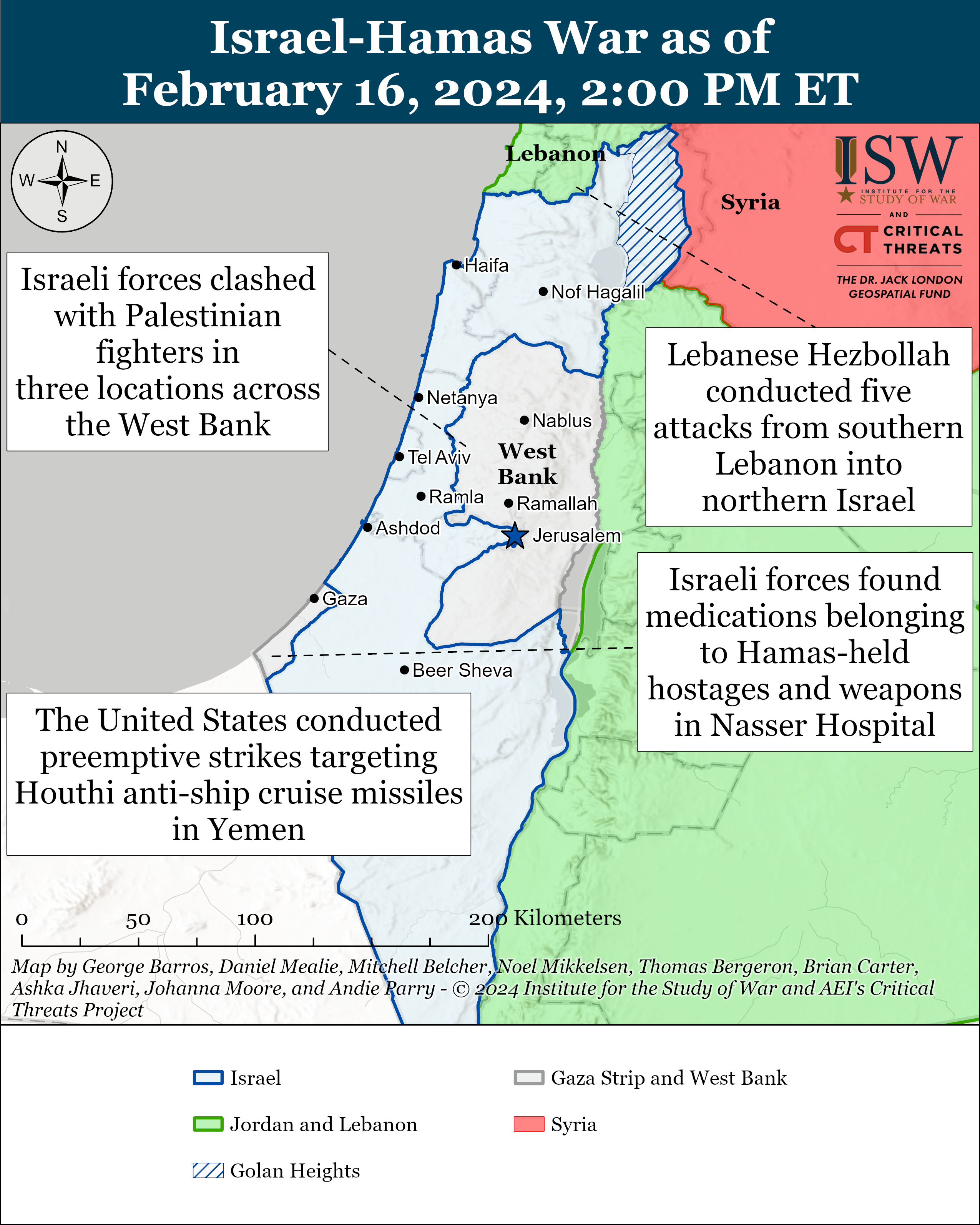
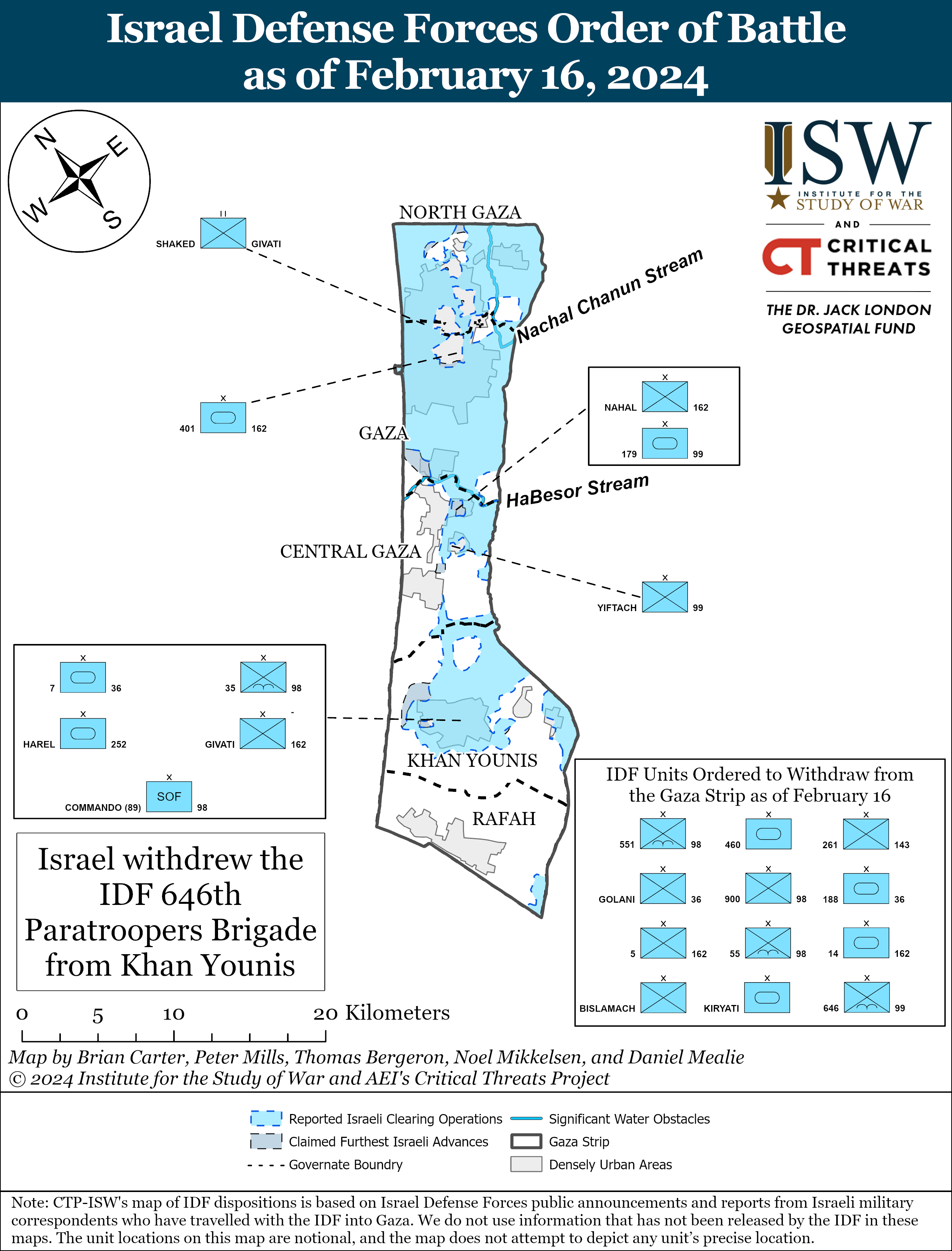
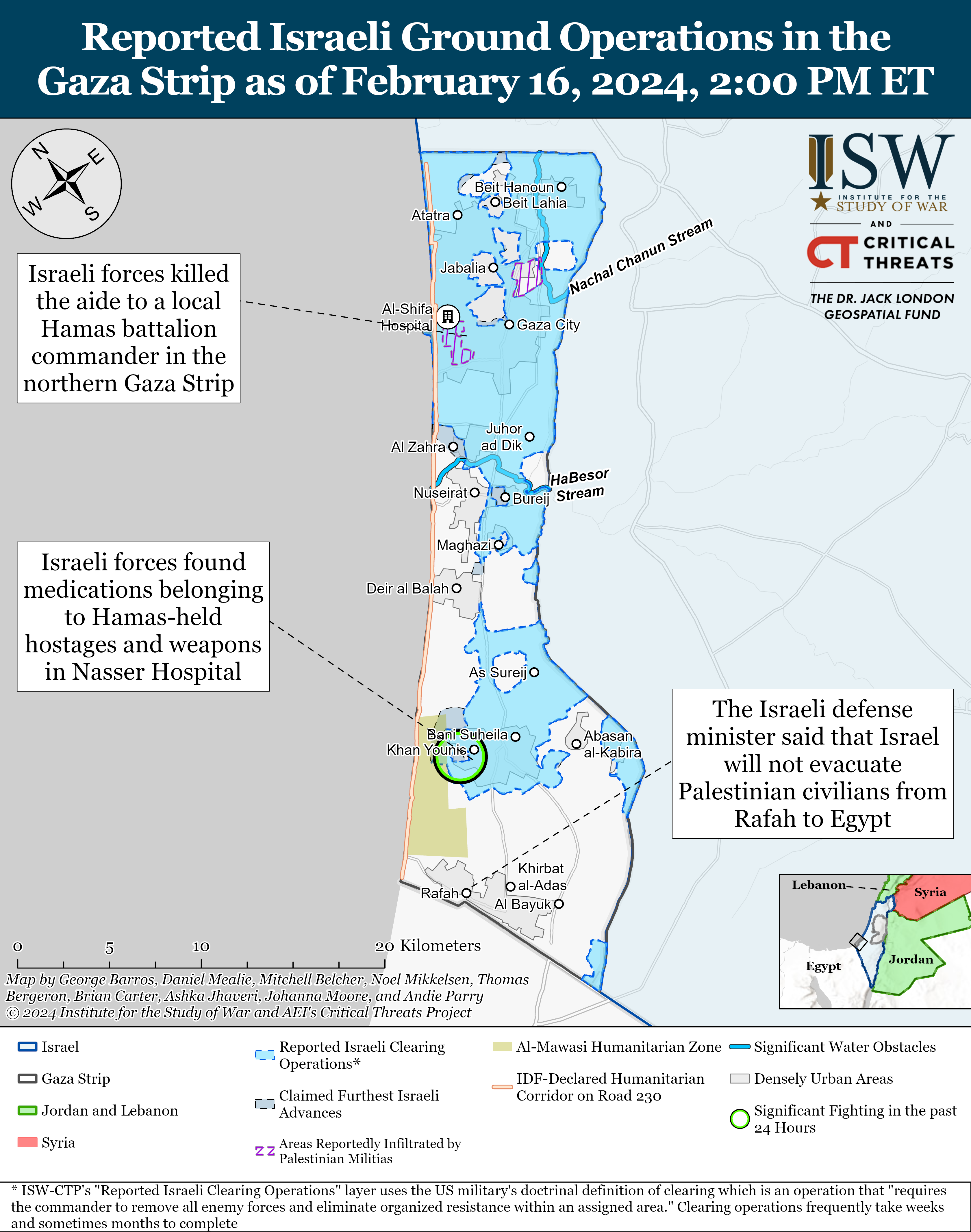
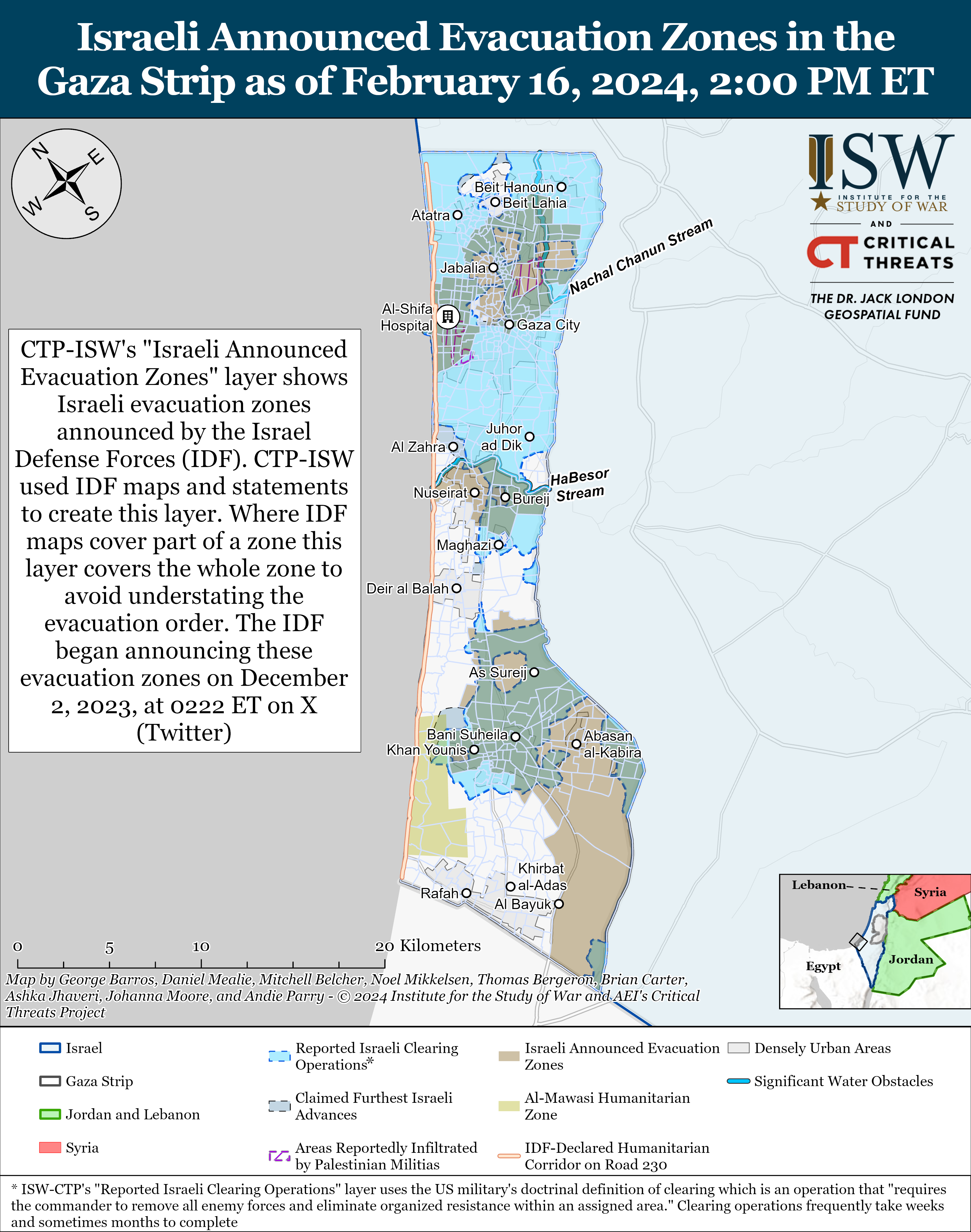
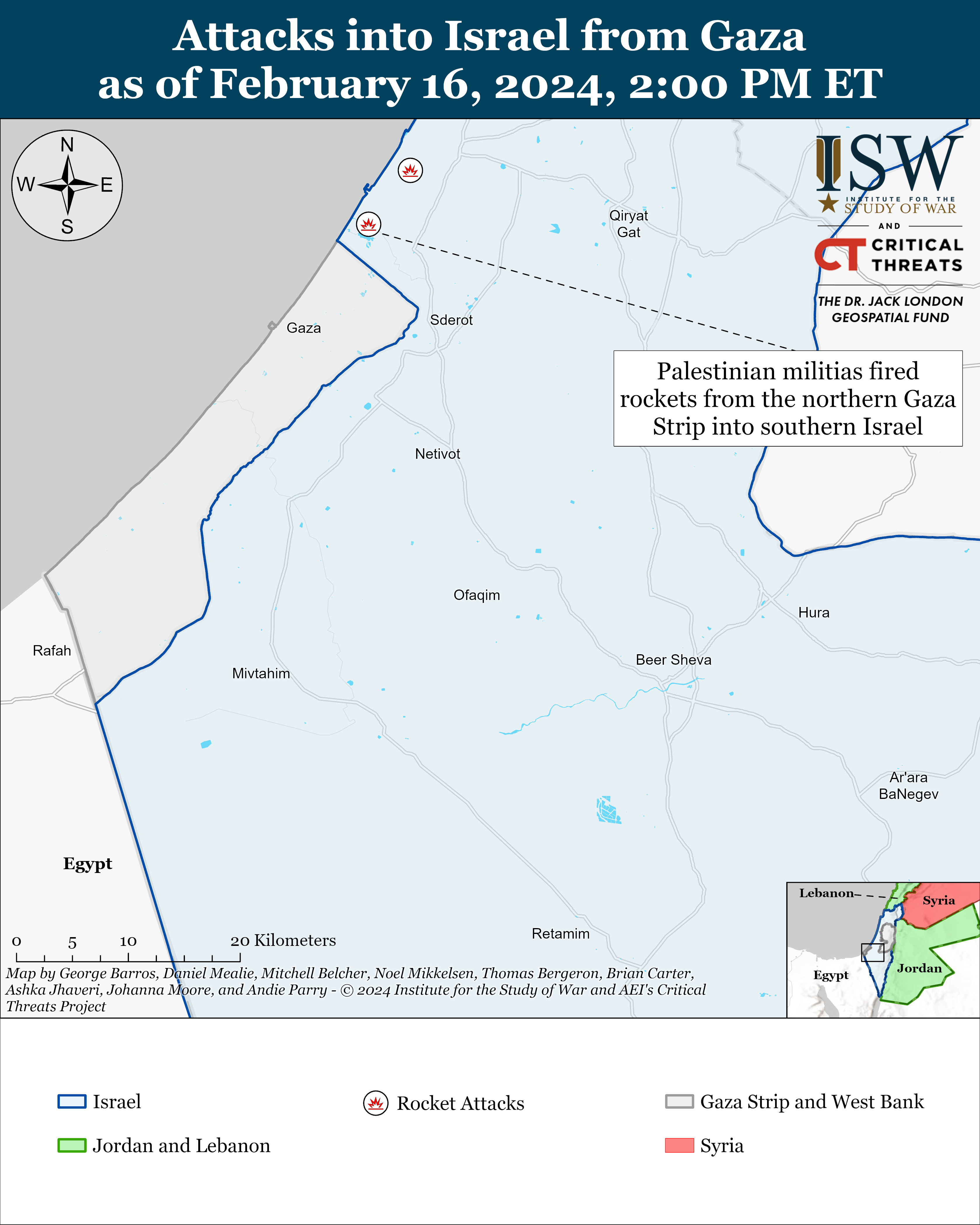
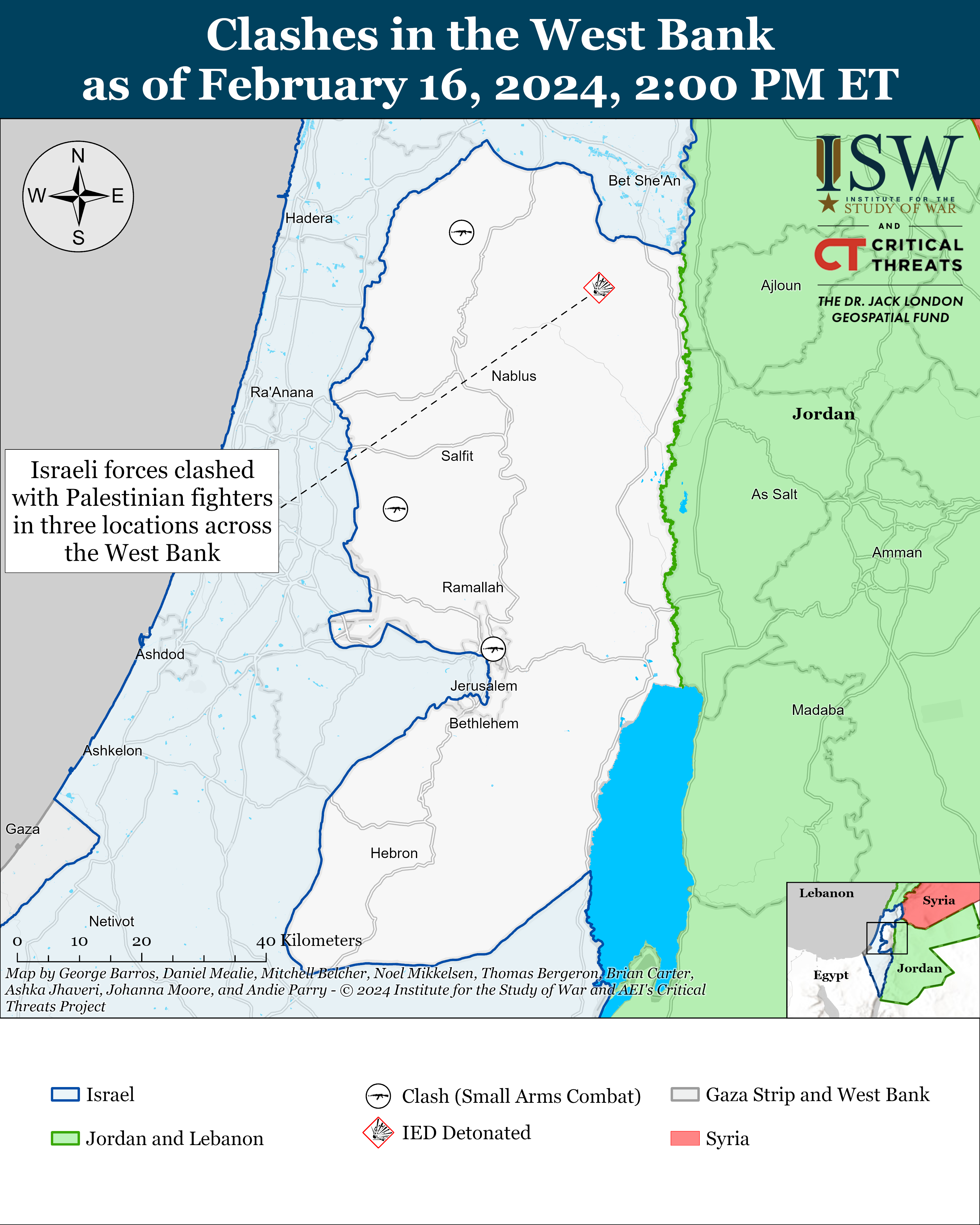
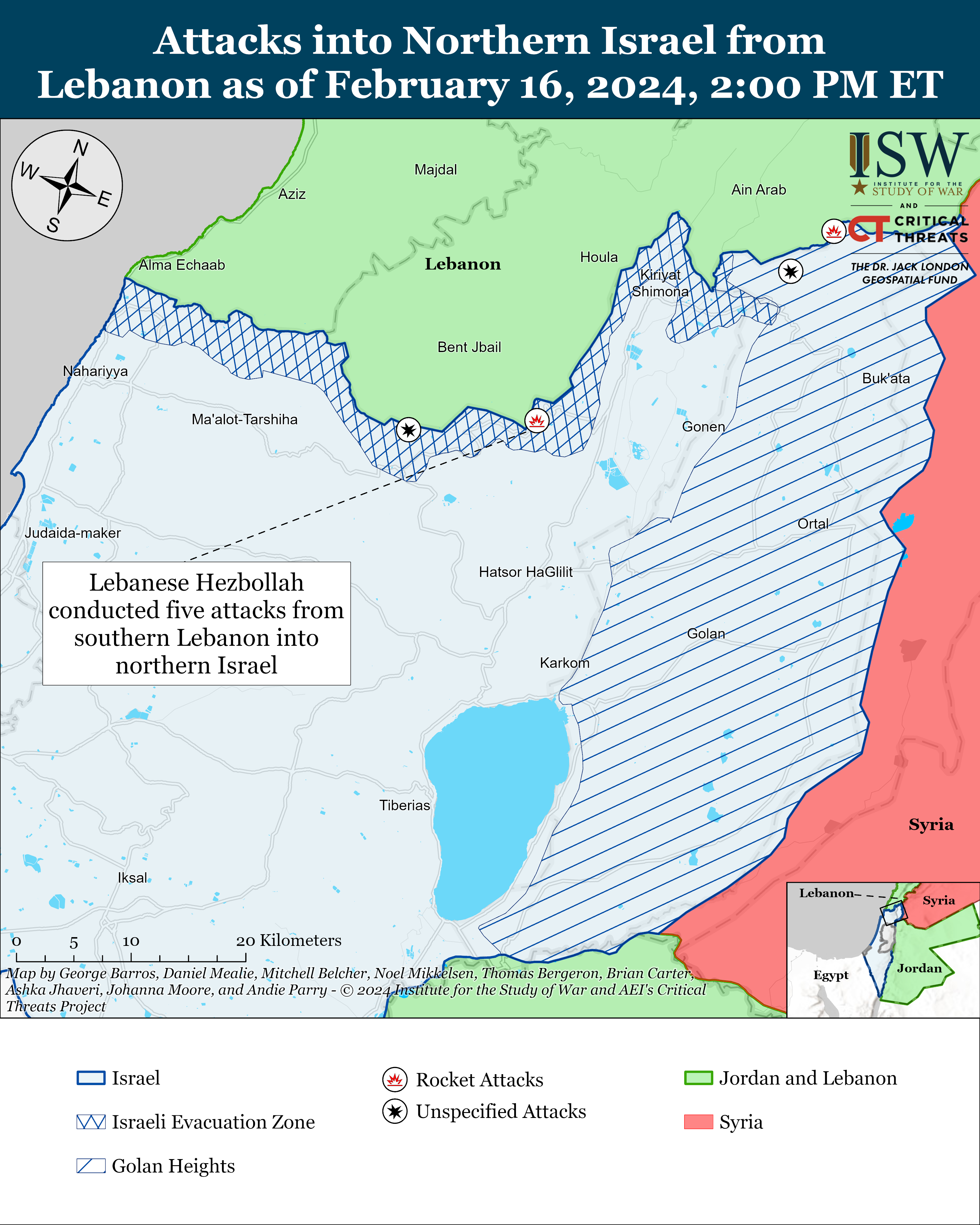
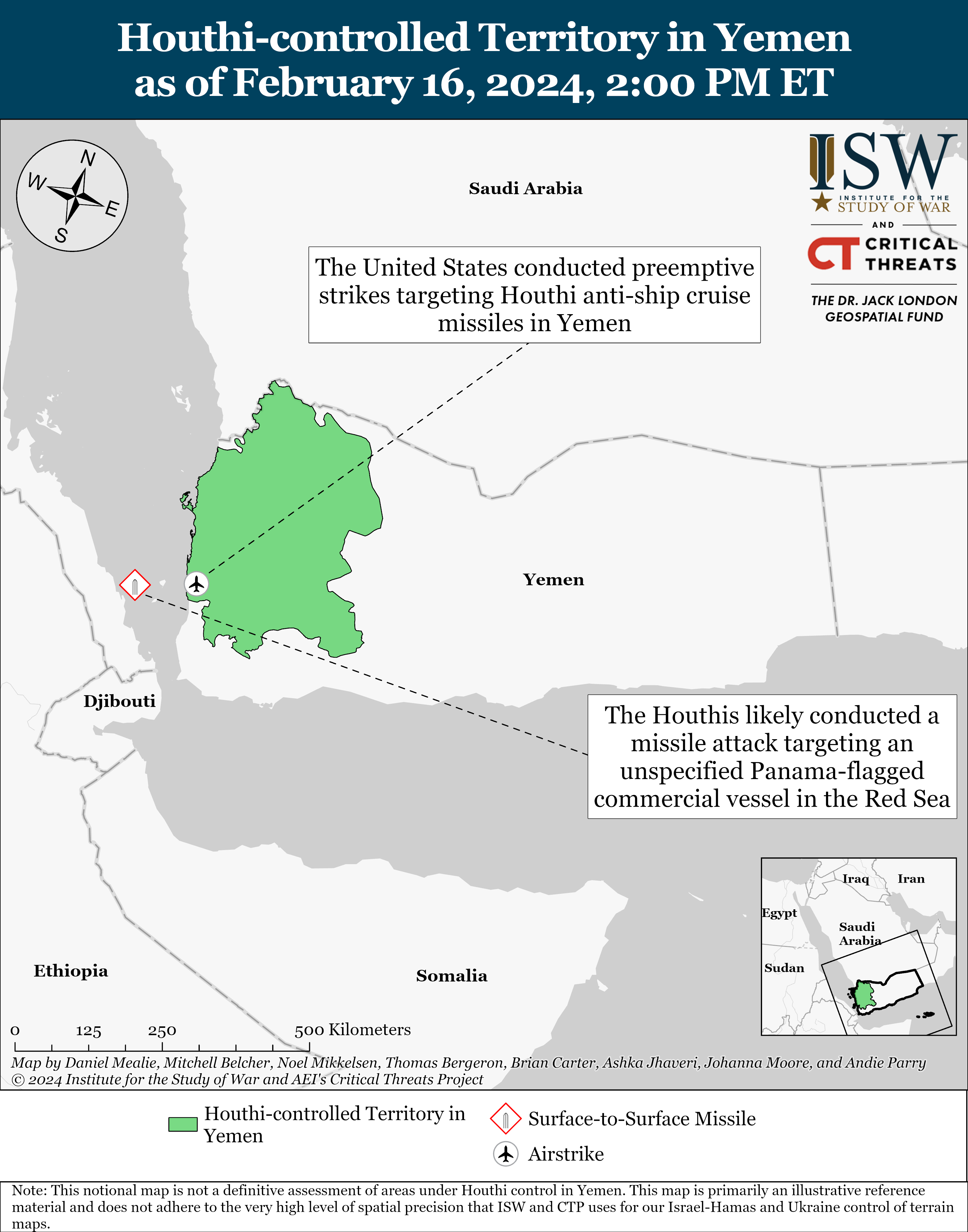
No comments:
Post a Comment